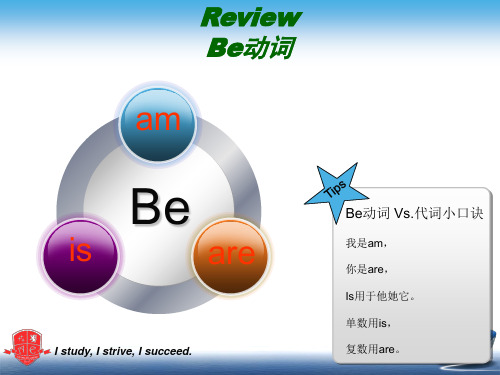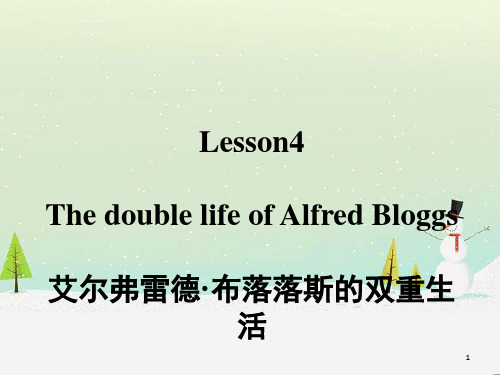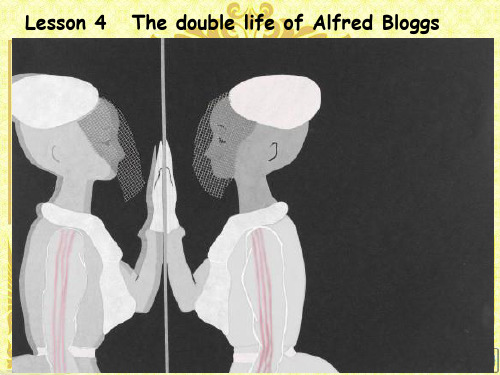新概念英语第三册Lesson3-4精品课件【公开课】
合集下载
新概念Lesson3-4(共33张PPT)

1. I a_m__ Yoyo. 2. She _i_s_ Lucy. 3. It __is_ a car. 4. We a_r_e_ the best. 5. He _i_s_ Rain 6. They _a_r_e from the USA.
I study, I strive, I succeed.
No,
否定回答
I study, I strive, I succeed.
is is not (isn’t)
this/that it it
a book. a book.
a book? is.
is not. (isn’t)
Grammar 语法
2. Be动词缩写形式
I am = I’m He is = He’s We are = We’re Here is = Here’s You are = You’re is not = isn’t are not = aren’t
你是Tom么? Are you Tom? 这是你的书么? Is this your book?
否定句:在Be动词后面加上not。
这不是我的房子。 This is not my house. 那不是我的车。 That is not my car.
I study, I strive, I succeed.
Words & Expressions 生词和短语
1.Excuse me! 2.Pardon?= I beg your pardon. 3.This/ That… 4.Thank you. 5.Very much
I study, I strive, I succeed.
Grammar 语法
否定句与一般疑问句的转换
I study, I strive, I succeed.
No,
否定回答
I study, I strive, I succeed.
is is not (isn’t)
this/that it it
a book. a book.
a book? is.
is not. (isn’t)
Grammar 语法
2. Be动词缩写形式
I am = I’m He is = He’s We are = We’re Here is = Here’s You are = You’re is not = isn’t are not = aren’t
你是Tom么? Are you Tom? 这是你的书么? Is this your book?
否定句:在Be动词后面加上not。
这不是我的房子。 This is not my house. 那不是我的车。 That is not my car.
I study, I strive, I succeed.
Words & Expressions 生词和短语
1.Excuse me! 2.Pardon?= I beg your pardon. 3.This/ That… 4.Thank you. 5.Very much
I study, I strive, I succeed.
Grammar 语法
否定句与一般疑问句的转换
新概念英语第三册第4课(课堂PPT)

Eg. She will always be showered with love, affection and adoration. 她一5 定 会沐浴在爱、亲情和赞美之中。
secret n.秘密 adj.秘密的, 隐秘的
confidential adj.机密的
keep a / one’s secret 保密
corporation n.公司,社团,团体
作有限公司解时,美国人多用corporation, 英语人多用company
firm 公司 (较广泛,统称)group 集团公司 listed company 股票上市公司 government-owned enterprise 国有企业
overalls n.工作服
working clothes; sports wear 运动服;nighty 睡衣 boiler(锅炉,热水器)suit 连体工作服
shower n.淋浴;阵雨;(一)阵,(一)批)
a shower of 一阵, 大量 a shower of criticism / arrows
be showered with 被大量给予…
Employment status就业状况;marital status 婚姻状况
A high status businessman 有地位的商人
6
Text 课文 Why did Alf want a white-collar job? The double life of Alfred Bloggs
-- It's between you and me. 此事只介于你我之间。 -- I'll keep it to myself. 我会保守秘密的。
in secret 私下里(= secretly, in private, privately) --
secret n.秘密 adj.秘密的, 隐秘的
confidential adj.机密的
keep a / one’s secret 保密
corporation n.公司,社团,团体
作有限公司解时,美国人多用corporation, 英语人多用company
firm 公司 (较广泛,统称)group 集团公司 listed company 股票上市公司 government-owned enterprise 国有企业
overalls n.工作服
working clothes; sports wear 运动服;nighty 睡衣 boiler(锅炉,热水器)suit 连体工作服
shower n.淋浴;阵雨;(一)阵,(一)批)
a shower of 一阵, 大量 a shower of criticism / arrows
be showered with 被大量给予…
Employment status就业状况;marital status 婚姻状况
A high status businessman 有地位的商人
6
Text 课文 Why did Alf want a white-collar job? The double life of Alfred Bloggs
-- It's between you and me. 此事只介于你我之间。 -- I'll keep it to myself. 我会保守秘密的。
in secret 私下里(= secretly, in private, privately) --
新概念英语第三册第4课最新优质ppt课件

-- It's between you and me. 此事只介于你我之间。
-- I'll keep it to myself. 我会保守秘密的。
in secret 私下里(= secretly, in private, privately ) --
I was told about it in secret.
? privileged a.荣幸的
? -- We are privileged to be together with professor Smith this evening.
4
? dustman n. 清洁工
garbage man; garbage collector; trash man; 清洁工;cleaner 保洁员 trashcan (AmE.) 垃圾筒;dustbin (BrE.)垃圾筒
? refer to...as = regard...as “把...叫作;把 …看作”
eg. We always refer to the teacher as a gardener.
for the simple reason = for 引导的原因状语从句
? for the reason that多用于正式文体,
Employment status就业状况;marital status 婚姻状况
A high status businessman 有地位的商人
6
? Text 课文 ? Why did Alf want a white-collar job? ? The double life of Alfred Bloggs
? working clothes; sports wear 运动服;nighty 睡衣 ? boiler(锅炉,热水器 )suit 连体工作服
新概念第三册lesson4(课堂PPT)

9
2.collar
White-collar白领 蓝领blue-collar 金领golden-collars 粉领pink-collars (工作高雅的女士,如模特,空姐等) 灰领 gray-collars (尤指服务行业)
10
3.sacrifice
To give sb. Sth. that you would prefer to keep vt.牺牲,献出 把某人的生命献给国家 sacrifice one's life for the country 牺牲时间 sacrifice time
Manu-手工的 -al 形容词或名词词缀
5
Manu-手工的
manuscript 手写稿 Manufacture手工制作 Manumit 释放 Manumission释放
mit= send,cast“送,放出” admit v 许可入学等;承认(ad+mit→送来→许可进
入) commit v 委托;委任 emit v 发光;发出(味等) permit v 许可,允许(per始终+mit→始终放出来→ 6
3
n.使用手册,说明书,指南 The manual is full of terminologies of science and technology. 同义词: Guide, handbook, directory notebooual可拆为: manu-al
Manu-反义词缀:
Auto-自动
Automatic transmission自动挡 ATM(automatic teller machine) automobile汽车 Autonomous region自治区
7
-al 表形容词词缀
2.collar
White-collar白领 蓝领blue-collar 金领golden-collars 粉领pink-collars (工作高雅的女士,如模特,空姐等) 灰领 gray-collars (尤指服务行业)
10
3.sacrifice
To give sb. Sth. that you would prefer to keep vt.牺牲,献出 把某人的生命献给国家 sacrifice one's life for the country 牺牲时间 sacrifice time
Manu-手工的 -al 形容词或名词词缀
5
Manu-手工的
manuscript 手写稿 Manufacture手工制作 Manumit 释放 Manumission释放
mit= send,cast“送,放出” admit v 许可入学等;承认(ad+mit→送来→许可进
入) commit v 委托;委任 emit v 发光;发出(味等) permit v 许可,允许(per始终+mit→始终放出来→ 6
3
n.使用手册,说明书,指南 The manual is full of terminologies of science and technology. 同义词: Guide, handbook, directory notebooual可拆为: manu-al
Manu-反义词缀:
Auto-自动
Automatic transmission自动挡 ATM(automatic teller machine) automobile汽车 Autonomous region自治区
7
-al 表形容词词缀
新概念英语第三册第3课课件

9.What hid the archaeologists do to the fragments?
They reconstructed then
(6).否定词用句首时 要倒装
1.否定词或具有否定含义的副词, 如:never .rarely .seldom.little . on no account 等用于句首时,必 须后接(be,do ,have,can,must,+ 主语+句子的其他部分)
Which it’s head was found among remains from the fifth century B.C.When the fragments mere reconstructed,they turned out to be a goddess which stood three feet high .Her hands rested on hips and she was wearing a full_length skirt .Her identity is unknown.
(13).remains
n. 遗物,遗迹,废墟
the remains of meal
the remains of ancient Rome
(14).classical
adj. (希腊和罗马)古文 化的
classical studies 古代文学 研究/古典研究 classical music 古典音乐
In the most sacred room of the temple ,clay fragments of fifteen statue were found
Each of these represented a goddess and had ,at one time ,been painted
新概念英语第三册Lesson3课件_PPT

10. Sacred adj. 神圣的,宗教的
a sacred place 圣地 a sacred oath[əʊθ] 神圣的誓言 sacred music 宗教音乐;sacred history 宗教史
Holy adj. 神圣的 the holy city: Jerusalem [dʒə'ru:sələm] 耶路撒冷 Holy shit 天啊!见鬼! Silent night, holy night, all is calm, all is bright. 平安夜,圣善夜,万暗中,光华射
civil servant 公仆
civil law 民法 civil war 内战
domestic adj. [dəˈmestɪk] 家庭的,国内的,驯养的 domestic market 国内市场 domestic violence 家庭暴力 domestic flights 国内航班
8. Storey n. 楼层(Am.E.: story)
be really hip 非常时尚 ass 屁股 buttock [ˈbʌtək] 臀部
full-length adj. (裙衣)拖地长的,全长的 A full-length skirt The boy lay at full length on the grass. 男孩伸直身体躺在草地上。 He fell full length. 他直挺挺地跌倒在地上。
e.g. If you reconstruct something that has been destroyed or badly damaged, you build it and make it work again.
The government must reconstruct the shattered(破碎的) economy. 政府必须重建支离破碎的经济。
新东方新概念英语课件第三册lesson 4.ppt

This can give rise to curious situations, as it did in the case of Alfred Bloggs who worked as a dustman for the Ellesmere Corporation.
give rise to: 引起 The bad conditions have given rise to a lot of crimes. in the case of: 就 - - -而言 Stealing is no shame in the case of him.
Get separated : 分手 Get divorced : 离婚
embarrass :令 - - -难堪 He embarrassed me in the public. 他当众让我为难堪.
Every morning, he left home dressed in a smart black suit. He then changed into overalls and spent the next eight hours as a dustman.
such…that…
Such is human nature = human nature is such 到了如此这般地步
Your kindness was such that we will never forget you.
Such was his kindness that we will never forget you.
Before returning home = Before he returned home. After doing: After returning home, he had a good rest. On doing: On returning home, he had a good rest.
新概念英语第三册PPT课件:NCE3_lesson03(共41页)

• Interviewer interviewee
• Fragment 碎片 • Frag-, fract 破裂 • Fragile [‘fræ dʒail] • fraction [‘fræ kʃən]部分 • fractional [‘fræ kʃənəl]很少的 • Fracture['fræ ktʃə]破裂、骨折
、效果为主语,强调对客观事实的陈述。
An American team explored a temple (which stands in an ancient city on the promontory of Ayia Irini.)
stand (vi.==)lsiietua(tvei.[)'s位it于jueit] (vt.)使位于,
• Do you know the statue? • Is she a modern-looking woman? • Is she a goddess? • Do you worship the goddess? • What is she wearing? • Can you make sure her identity?
civilize (v)使某人开化 civilized (adj) 文明的 有礼貌 的
worship <n./v.> 祟拜 ,敬仰
respect vt.尊敬, 尊重 admire v.赞美, 钦佩, 羡慕 Who do you worship in the world? a blind worship 盲目的崇拜
第1 章
ቤተ መጻሕፍቲ ባይዱText
Aegean
• Some time ago, an interesting discoverywa s made by archaeologists on the
- 1、下载文档前请自行甄别文档内容的完整性,平台不提供额外的编辑、内容补充、找答案等附加服务。
- 2、"仅部分预览"的文档,不可在线预览部分如存在完整性等问题,可反馈申请退款(可完整预览的文档不适用该条件!)。
- 3、如文档侵犯您的权益,请联系客服反馈,我们会尽快为您处理(人工客服工作时间:9:00-18:30)。
Lesson 3 Some time ago, an interesting discovery was made by archaeologists on the Aegean island of Kea. An American team explored a temple which stands in an ancient city on the promontory of Ayia Irini. The city at one time must have been prosperous, for it enjoyed a high level of civilization. Houses---often three storeys high----were built of stone. They had large rooms with beautifully decorated walls. The city was even equipped with a drainage system, for a great many clay pipes were found beneath the narrow streets.
Lesson 3 10 How long had the temple they explored been used as a place of worship? (From the fifteenth century B.C.until Roman times.) 11 They found fragments of statues. How many statues? (Fifteen.) 12 What did these statues represent? (Goddesses.)
Lesson 3
Lesson 3
Lesson 3
Lesssson 3
Lesson 3
Lesson 3
Lesson 3
Lesson 3
Lesson 3
Lesson 3
Lesson 3
Lesson 3
Lesson 3
Lesson 3
Lesson 3 6 What were they built of? (Stone.) 7 They weren't made of wood, were they? (No, they weren't.) 8 What were these houses like? (They had large rooms and were beautifully decorated.) 9 What was the city equipped with? (A drainage system.)
Lesson 3 13 What was interesting about the body and head of one of the statues? (The body was among remains dating from the fifteenth century and the head among the remains of the fifth century B.C.) 14 When had the head been found and preserved? (In Classical times.) 15 What did the archaeologists do to the fragments? (They reconstructed them.)
Lesson 3 When the archaeologists reconstructed the fragments, they were amazed to find that the goddess turned out to be a very modernlooking woman. She stood three feet high and her hands rested on her hips. She was wearing a full-length skirt which swept the ground. Despite her great age, she was very graceful indeed, but, so far, the archaeologists have been unable to discover her identity.
Lesson 3 Listen to the tape then answer the question below.听录音,然后回答以下问题。 How did the archaeologists know that the statue was a goddess? Because the fragment were found in the most sacred room of the temple.
Lesson 3
1 the Aegean island of Kea, 爱琴海的基亚岛。爱琴海 是东地中海的一部分,位于希腊半岛和小亚细亚之间。 它包括希腊半岛以外的许多岛屿。基亚岛位于希腊半岛 东南方的海域里。 2 Ayia Irini, 阿伊亚· 依里尼,意为“圣依里尼”, Irini 是希腊文,意为“和平” 3 The city at one time must have been prosperous, for it enjoyed a high level of civilization. 这座古城肯 定一度很繁荣,因为它曾享有高度的文明。 must have been是对过去的推测。 at one time, 一度。 4 Roman times, 罗马时代。指古罗马(约公元前 200公元 400)时期,那时罗马人在欧洲建立了帝国。 5 date from, 追溯到。 6 Classical times, 指古希腊,古罗马时代。 7 the goddess turned out to be…, 那位女神原来 是……。
倚放,放置 n.文明 n.屁股,臀部 n.楼层 (裙衣)拖地长的 n.排水 adj.优雅的 n.祟拜 .身份
Lesson 3
Lesson 3
Lesson 3
Lesson 3
Lesson 3
Lesson 3
Lesson 3
n.女神 adj.宗教的,神圣的 n.考古学家 n.碎片 adj.爱琴海的 n.遗物,遗迹,废墟 v.考察,勘探 adj.(希腊和罗马)古 文化的 n.海角 adj.(经济上)繁荣 v.修复的,昌盛的 倚放,放置 n.文明 n.屁股,臀部 n.楼层 (裙衣)拖地长的 n.排水 adj.优雅的 n.祟拜 .身份
n.女神 adj.宗教的,神圣的 n.考古学家 n.碎片 adj.爱琴海的 n.遗物,遗迹,废墟 v.考察,勘探 adj.(希腊和罗马)古 文化的 n.海角 adj.(经济上)繁荣 v.修复的,昌盛的
Lesson 3 restv. civilization. hip storey full-length drainage graceful worship identityn
Lesson 3 16 And what was the result? (The goddess turned out to be a very modern-looking woman.) 17 What did she look like? (She was three feet high and her hands rested on her hips.) 18 What was she wearing? (A full-length skirt.)
Lesson 3 An unknown goddess
Lesson 3 1 Where was this interesting discovery made? (On the Aegean island of Kea.) 2 What did the American team explore? (A temple which stands in an ancient city.) 3 It's in a place called Ayia Irini, isn't it? (Yes, it is.) 4 How do we know the city must have been prosperous? (Because it enjoyed a high level ofcivilization.) 5 How high were some of the houses? (Three storeys.)
Lesson 3
Lesson 3 Archaeologists found clay fragments in an ancient temple. These represented the fifteen statues of goddesses which had once been painted. The body of one statue was found among remains from the fifteenth century B.C. while its head was found a mong remains from the fifth century B.C. When thefragments were reconstructed, they turned out to be a goddess which stood three feet high. Her hands rested on her hips and she was wearing a full-length skirt. Her identity is unknown. (80 words)
Lesson 3 After walking round the ancient city, the archaeologists…This temple… On entering the sacred room, the archaeologists… After this, workmen began digging and soon discovered…They also found…The archaeologists carefully… They were astonished to find that… The goddess was… She… Although the archaeologists… they were unable to find out her name. (52 words)
